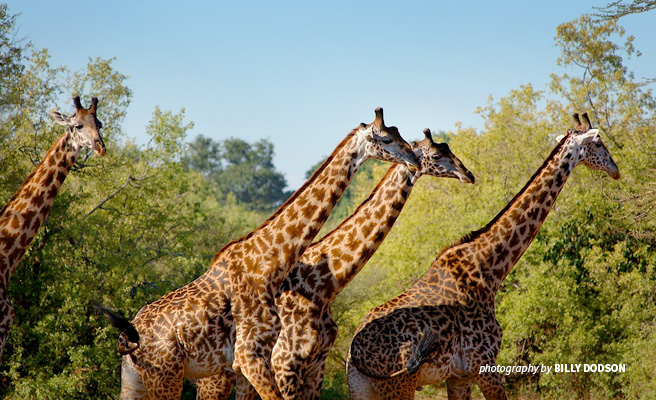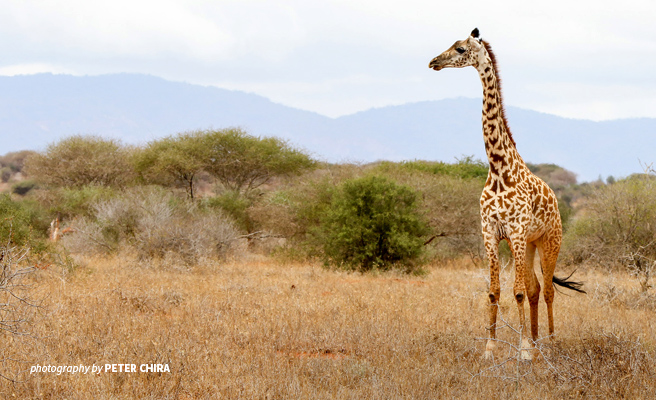Investigations show giraffes are threatened by bushmeat trade, demand for body parts

The population of the world’s tallest land mammal is shrinking. Over the last three decades, giraffe numbers have dropped 38 percent — from 157,000 in 1985 to an estimated 97,500 in 2015. This decline led the International Union for Conservation of Nature in 2016 to heighten giraffes’ conservation status from “least concern” to “vulnerable.” More recently, IUCN uplisted multiple giraffe subspecies even further: The Kordofan and Nubian giraffes, who together have around 4,500 mature adults, are now classified as critically endangered, while the reticulated giraffe is classified as endangered.
The leading threats to giraffe populations are habitat loss and, perhaps lesser-known, hunting and poaching. In August 2019, the Convention on International Trade in Endangered Species of Wild Fauna and Flora voted to impose restrictions on the sale of giraffe parts by placing all nine subspecies in Appendix II. African Wildlife Foundation helped add to the body of knowledge about giraffes and the bushmeat trade in 2018 when it worked with the Kenya Wildlife Service to investigate samples of meat sold in butcher shops in the Tsavo landscape. DNA analysis showed that Kenyans often unknowingly eat giraffe bushmeat disguised as beef. These results and the diminishing number of giraffes tell us stronger laws are needed to halt the illegal bushmeat trade (as well as poaching for body parts — giraffe tails are status symbols in some places and used in dowries.)
Recognizing the need for urgent action, AWF, Kenya Wildlife Service, and other partners collaborated on a first-ever giraffe conservation strategy, the “Recovery and Action Plan for Giraffe in Kenya.” The plan, launched in November 2018, runs through 2022. It calls for a holistic strategy including enhanced species protection, improved land management, coordinated research and monitoring of giraffe populations, as well as education and awareness. AWF is a member of the National Giraffe Conservation Task Force in Kenya.

Giraffe populations in Manyara Ranch Conservancy are recovering thanks to concerted anti-poaching efforts
Landscape conservation revives previously destroyed giraffe habitat
AWF fights for the giraffe in the field as well as in the investigative and policy realms. In Tanzania, between Tarangire and Lake Manyara National Parks lies Manyara Ranch, a critical corridor where giraffe, elephant, and other iconic wildlife roam and forage. A few years ago, the ranch was in bad shape. For one thing, poachers had put the area’s elephants and other wildlife under siege. “It was poaching from corner to corner, one day over here, another day over there,” says Fidelis Olekashe, AWF’s Manyara Ranch manager. To stem the carnage, AWF partnered with the Arusha-based Honeyguide Foundation, known for its anti-poaching field work. AWF and Honeyguide trained a team of nine rangers and deployed them at the ranch, along with skilled tracker dogs. The Canines for Conservation program has proven to be an effective poaching deterrent, especially when combined with other protection tactics. Our skilled dogs and handlers can track down even those offenders who have fled the scene to hide out in neighboring settlements.
The second problem at Manyara Ranch was overgrazing that had badly degraded the habitat. AWF works persistently with communities to improve grazing practices. Our support of community services such as the clinic and schools helped forge good relations, as did our provision of veterinary services and superior breeding bulls for the Maasai’s all-important livestock herds. We also trained Maasai communities in the use of predator-proof bomas to protect their livestock from lions and hyenas.
“The communities have learned, and they see what we do for them,” says Olekashe. He extends his arm to indicate the Manyara Ranch grounds, where grasses now flourish and giraffe, elephant, eland, and other wildlife have returned in good numbers. “They support us, and they support protection of the wildlife. And that’s why the ranch looks like this now.”
The best news? Since 2015 inside the ranch, there have been no poaching incidents.

Wildlife management authorities collaborate across the Kenya-Tanzania border to mitigate threats to vulnerable giraffe populations
Giraffe conservation embedded in sustainable development
Long-term giraffe conservation requires working in large landscapes, which is AWF’s specialty. In the Tsavo-Mkomazi (Kenya and Tanzania) transboundary area — one of the Maasai giraffe’s last strongholds — AWF is implementing a holistic conservation strategy.
Although the Tsavo-Mkomazi giraffe population doubled from an estimated 2,891in 2014 to 4,323 in 2017, data also show giraffes are struggling outside the protected zone. As in many parts of East Africa, human settlement is expanding, transforming vital buffer zones and habitat into farmland and putting enormous pressure on wildlife food resources.
With support from our partners, AWF recently launched a project to support giraffe populations in this critical landscape. Objectives include:
- Establishing baseline population data
- Mitigating poaching and human-wildlife conflict
- Engaging communities in conservation and compatible development
- Helping secure a future for giraffe through proven strategies including tourism
Concerted and well-planned efforts like these will help ensure that the giraffe remains a vital and iconic part of African landscapes.